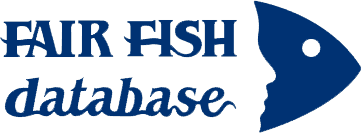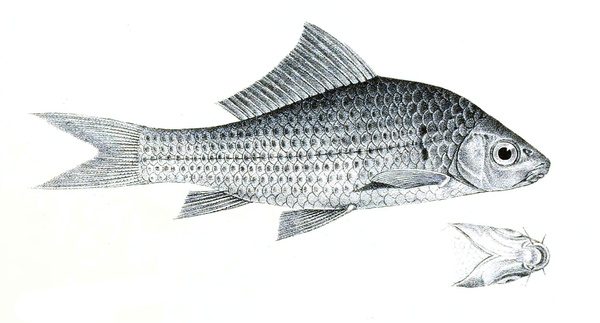Information
Version: C | 1.0 (2022-12-29)
Please note: This part of the profile is currently being revised.
WelfareScore | farm
Condensed assessment of the species' likelihood and potential for good fish welfare in aquaculture, based on ethological findings for 10 crucial criteria.
- Li = Likelihood that the individuals of the species experience good welfare under minimal farming conditions
- Po = Potential of the individuals of the species to experience good welfare under high-standard farming conditions
- Ce = Certainty of our findings in Likelihood and Potential
WelfareScore = Sum of criteria scoring "High" (max. 10)
General remarks
Osteochilus vittatus is an Asian freshwater tropical barb that naturally inhabits Indochina, Thailand, and Indonesia. It is a BENTHOPELAGIC fish that is usually found in large streams with slow-moving waters and muddy to sandy substrate, but also occurs in rivers, ponds, floodplains, and reservoirs. This cyprinid can be used as a biological agent to reduce the blooming of phytoplankton. Although O. vittatus has slow growth and bony meat, it has a good taste, high protein and calcium content, and a strategic value as a source of food without cholesterol, resulting in substantial economic value. It is also attractive as an ornamental fish. O. vittatus is classified as a Least Concern species by IUCN yet threats to its natural populations include overfishing, damming rivers, sand mining, habitat loss, habitat degradation (including eutrophycation), and introduction of exotic FISHES. This cyprinid can be cultured extensively or polycultured with other species, such as Cyprinus carpio, Oreochomis niloticus or Osphronemus goramy, but thereby lowering its productivity. Regarding the welfare assessment of this species, wild information for a better evaluation is still missing, especially about home range and aggregation patterns and about more specific information for eggs, larvae, fry, and spawners. Moreover, farming information about aggression, stress response, and malformations as well as more specific information for larvae, fry, and spawners is also missing.
1 Home range
Many species traverse in a limited horizontal space (even if just for a certain period of time per year); the home range may be described as a species' understanding of its environment (i.e., its cognitive map) for the most important resources it needs access to.
What is the probability of providing the species' whole home range in captivity?
It is unclear for minimal and high-standard farming conditions. Our conclusion is based on a low amount of evidence.


2 Depth range
Given the availability of resources (food, shelter) or the need to avoid predators, species spend their time within a certain depth range.
What is the probability of providing the species' whole depth range in captivity?
It is low for minimal farming conditions. It is medium for high-standard farming conditions. Our conclusion is based on a low amount of evidence.


3 Migration
Some species undergo seasonal changes of environments for different purposes (feeding, spawning, etc.), and to move there, they migrate for more or less extensive distances.
What is the probability of providing farming conditions that are compatible with the migrating or habitat-changing behaviour of the species?
It is low for minimal farming conditions. It is medium for high-standard farming conditions. Our conclusion is based on a medium amount of evidence.


4 Reproduction
A species reproduces at a certain age, season, and sex ratio and possibly involving courtship rituals.
What is the probability of the species reproducing naturally in captivity without manipulation of theses circumstances?
It is low for minimal and high-standard farming conditions. Our conclusion is based on a high amount of evidence.


5 Aggregation
Species differ in the way they co-exist with conspecifics or other species from being solitary to aggregating unstructured, casually roaming in shoals or closely coordinating in schools of varying densities.
What is the probability of providing farming conditions that are compatible with the aggregation behaviour of the species?
It is unclear for minimal and high-standard farming conditions. Our conclusion is based on a low amount of evidence.


6 Aggression
There is a range of adverse reactions in species, spanning from being relatively indifferent towards others to defending valuable resources (e.g., food, territory, mates) to actively attacking opponents.
What is the probability of the species being non-aggressive and non-territorial in captivity?
It is unclear for minimal and high-standard farming conditions. Our conclusion is based on a low amount of evidence.


7 Substrate
Depending on where in the water column the species lives, it differs in interacting with or relying on various substrates for feeding or covering purposes (e.g., plants, rocks and stones, sand and mud, turbidity).
What is the probability of providing the species' substrate and shelter needs in captivity?
It is unclear for minimal and high-standard farming conditions. Our conclusion is based on a low amount of evidence.


8 Stress
Farming involves subjecting the species to diverse procedures (e.g., handling, air exposure, short-term confinement, short-term crowding, transport), sudden parameter changes or repeated disturbances (e.g., husbandry, size-grading).
What is the probability of the species not being stressed?
There are no findings for minimal and high-standard farming conditions.


9 Malformations
Deformities that – in contrast to diseases – are commonly irreversible may indicate sub-optimal rearing conditions (e.g., mechanical stress during hatching and rearing, environmental factors unless mentioned in crit. 3, aquatic pollutants, nutritional deficiencies) or a general incompatibility of the species with being farmed.
What is the probability of the species being malformed rarely?
It is unclear for minimal and high-standard farming conditions. Our conclusion is based on a low amount of evidence.


10 Slaughter
The cornerstone for a humane treatment is that slaughter a) immediately follows stunning (i.e., while the individual is unconscious), b) happens according to a clear and reproducible set of instructions verified under farming conditions, and c) avoids pain, suffering, and distress.
What is the probability of the species being slaughtered according to a humane slaughter protocol?
It is low for minimal farming conditions. It is medium for high-standard farming conditions. Our conclusion is based on a low amount of evidence.


Side note: Domestication
Teletchea and Fontaine introduced 5 domestication levels illustrating how far species are from having their life cycle closed in captivity without wild input, how long they have been reared in captivity, and whether breeding programmes are in place.
What is the species’ domestication level?
DOMESTICATION LEVEL 3 29, level 5 being fully domesticated.
Side note: Forage fish in the feed
450-1,000 milliard wild-caught fishes end up being processed into fish meal and fish oil each year which contributes to overfishing and represents enormous suffering. There is a broad range of feeding types within species reared in captivity.
To what degree may fish meal and fish oil based on forage fish be replaced by non-forage fishery components (e.g., poultry blood meal) or sustainable sources (e.g., soybean cake)?
All age classes:
- WILD: omnivorous 8 and detritivorous 30 25, but mainly herbivorous 30 11.
- FARM: no data found yet.
- LAB: FRY: fish oil may be not replaced by sustainable sources 31.
Glossary
BENTHOPELAGIC = living and feeding near the bottom of a body of water, floating above the floor
DOMESTICATION LEVEL 3 = entire life cycle closed in captivity with wild inputs 29
FARM = setting in farming environment or under conditions simulating farming environment in terms of size of facility or number of individuals
FISHES = Using "fishes" instead of "fish" for more than one individual - whether of the same species or not - is inspired by Jonathan Balcombe who proposed this usage in his book "What a fish knows". By referring to a group as "fishes", we acknowledge the individuals with their personalities and needs instead of an anonymous mass of "fish".
FRY = larvae from external feeding on, for details ➝ Findings 10.1 Ontogenetic development
IND = individuals
JUVENILES = fully developed but immature individuals, for details ➝ Findings 10.1 Ontogenetic development
LAB = setting in laboratory environment
LARVAE = hatching to mouth opening, for details ➝ Findings 10.1 Ontogenetic development
PHOTOPERIOD = duration of daylight
POTAMODROMOUS = migrating within fresh water
SPAWNERS = adults during the spawning season; in farms: adults that are kept as broodstock
WILD = setting in the wild
Bibliography
2 Maulidyasari, S., and Djumanto Djumanto. 2020. Biological Parameters of Bonylip Barb (Osteochilus Vittatus Valenciennes, 1842) in Lake Rawa Pening Semarang Regency. Jurnal Iktiologi Indonesia 20: 251–261. https://doi.org/10.32491/jii.v20i3.531.
3 Sawestri, S., and Herlan. 2020. Diversity and length-weight relationships of fishes from Lake Cala in tide season. IOP Conf. Series: Earth and Environmental Science 535: 012038. https://doi.org/10.1088/1755-1315/535/1/012038.
4 Yunida, R., P. Sukardi, and S. Simanjuntak. 2019. Digestive Enzyme Activities of Osteochilus vittatus with Spirulina platensis Feed Supplementation in Biofloc System. Journal of Biology & Biology Education 11: 369–376. https://doi.org/10.15294/biosaintifika.v11i3.19108.
5 Aryani, N., A. Mardiah, Azrita, and H. Syandri. 2017. Influence of Different Stocking Densities on Growth, Feed Efficiency and Carcass Composition of Bonylip Barb (Osteochilus vittatus Cyprinidae) Fingerlings. Pakistan journal of biological sciences: PJBS 20: 489–497. https://doi.org/10.3923/pjbs.2017.489.497.
6 Syandri, H., Azrita, Niagara, and Junaidi. 2015. Preliminary Study on the Feeding Schedule of Laboratory Reared of Bonylip barb Larva, Osteochilus vittatus Cyprinidae. Journal of Aquaculture Research & Development 6: 1000368. https://doi.org/10.4172/2155-9546.1000368.
7 Muchlisin, Z. A., G. Arfandi, M. Adlim, N. Fadli, and S. Sugianto. 2014. Induced spawning of seurukan fish, Osteochilus vittatus (Pisces: Cyprinidae) using ovaprim, oxytocin and chicken pituitary gland extracts. AACL Bioflux 7: 412–418.
8 Froese, R., and D. Pauly. 2022. Osteochilus vittatus, Bonylip barb: fisheries, aquaculture. World Wide Web electronic publication. FishBase.
9 Kottelat, M. 1998. Fishes of the Nam Theun and Xe Bangfai basins, Laos, with diagnoses of twenty-two new species (Teleostei: Cyprinidae, Balitoridae, Cobitidae, Coiidae and Odontobutidae). Ichthyological exploration of freshwaters 9: 1–128.
10 Timorya, Y., A. Abdullah, A. S. Batubara, and Z. A. Muchlisin. 2018. Conservation and economic status fishes in the Krueng Sabee River, Aceh Jaya District, Aceh Province, Indonesia. IOP Conference Series: Earth and Environmental Science 216: 012044. https://doi.org/10.1088/1755-1315/216/1/012044.
11 Kaban, S., M. E. Armanto, M. R. Ridho, P. L. Hariani, and A. D. Utomo. 2019. Growth pattern, reproduction and food habit of palau fish Osteochilus vittatus in Batanghari River, Jambi Province, Indonesia. IOP Conference Series: Earth and Environmental Science 348: 012015. https://doi.org/10.1088/1755-1315/348/1/012015.
12 Syandri, H., Azrita, and Junaidi. 2015. Fecundity of Bonylip barb (Osteochilus vittatus Cyprinidae) in different waters habitats. International Journal of Fisheries and Aquatic Studies 2: 157–163.
13 Sokheng, Chan, Chhuon Kim Chhea, Sintavong Viravong, Kongpeng Bouakhamvongsa, Ubolratana Suntornratana, Noppanum Yoorong, Nguyen Than Tung, Tran Quoc Bao, Anders F. Poulsen, and John Valbo Jorgensen. 1999. Fish migrations and spawning habits in the Mekong mainstream: a survey using local knowledge (basin-wide). Assessment of Mekong Fisheries: Fish Migrations and Spawning and the Impact of Water Management Project (AMFC). Vientiane, Lao PDR: Mekong River Commission.
14 Riede, K. 2004. Global register of migratory species - from global to regional scales. Final report of the R&D Projekt 808 05 081. Bonn, Germany: Federal Agency for Nature Conservation.
15 Dina, R., G. S. Haryani, S. H. Nasution, O. Samir, and Lukman. 2020. Fish distribution in Ranggeh and Batang Air Stream, Tanjung Raya, Agam District, West Sumatra Province. IOP Conference Series: Earth and Environmental Science 535: 012062. https://doi.org/10.1088/1755-1315/535/1/012062.
16 NOT FOUND
17 Soulivongsa, L., B. Tengjaroenkul, and L. Neeratanaphan. 2020. Effects of Contamination by Heavy Metals and Metalloids on Chromosomes, Serum Biochemistry and Histopathology of the Bonylip Barb Fish Near Sepon Gold-Copper Mine, Lao PDR. International Journal of Environmental Research and Public Health 17: E9492. https://doi.org/10.3390/ijerph17249492.
18 Baensch, H. A., and R. Riehl. 1991. Aquarien Atlas, Band 3. Melle, Germany: Mergus Verlag.
19 Rochmatin, S. Y., A. Solichin, and S. W. Saputra. 2014. ASPEK PERTUMBUHAN DAN REPRODUKSI IKAN NILEM (Osteochilus hasselti) DI PERAIRAN RAWA PENING KECAMATAN TUNTANG KABUPATEN SEMARANG. Diponegoro Journal Of Maquares, Management of Aquatic Resources 3: 153–159.
20 Yusnita, D., Y. Ibrahim, and F. Saputra. 2019. The effects of turmeric flour Curcuma longa on fertilization, hatching and survival rates of seurukan fish Osteochilus vittatus. IOP Conference Series: Earth and Environmental Science 348: 012042. https://doi.org/10.1088/1755-1315/348/1/012042.
21 Adami, Y., N. Fadli, N. Nurfadillah, K. Eriani, Z. Jalil, and Z. A. Muchlisin. 2016. A preliminary observation on the effect of sperm extenders on the fertilization and hatching rates of seurukan fish (Osteochilus vittatus) eggs. AACL Bioflux 9: 300–304.
22 Habibah, A. N., R. P. C. Pertiwi, and T. Chasanah. 2020. Gonadal Differentiation of Nilem Fish (Osteochilus vittatus) Utilizing Temperature Treatment. BIOEDUSCIENCE 4: 143–147. https://doi.org/10.22236/j.bes/425704.
23 Herawati, H., Z. Firdaus, E. Hasan, and Rochima. 2019. Effect of Diffuser Aerator to Increase Growth of Nilem (Osteochilus vittatus) Cultivation With Different Density Introductions. Global Scientific Journals 7: 688–696.
24 Rainboth, W. J. 1996. Fishes of the Cambodian Mekong. Rome: Food & Agriculture Org.
25 Amarasinghe, U. S., W. S. Weliange, M. Kakkaeo, M. C. Villanueva, and J. Moreau. 2008. Diel feeding pattern and food consumption of selected fish populations in Asian reservoirs. In Aquatic ecosystems and …, 249–264.
26 European Food Safety Authority (EFSA). 2009. Species-specific welfare aspects of the main systems of stunning and killing of farmed Carp. EFSA Journal 1013: 1–37. https://doi.org/10.2903/j.efsa.2009.1013.
27 Rahmanifarah, K., B. Shabanpour, and A. Sattari. 2011. Effects of Clove Oil on Behavior and Flesh Quality of Common Carp (Cyprinus carpio L.) in Comparison with Pre-slaughter CO2 Stunning, Chilling and Asphyxia. Turkish Journal of Fisheries and Aquatic Sciences 11: 139–147.
28 Retter, Karina, Karl-Heinz Esser, Matthias Lüpke, John Hellmann, Dieter Steinhagen, and Verena Jung-Schroers. 2018. Stunning of common carp: Results from a field and a laboratory study. BMC Veterinary Research 14: 1–11. https://doi.org/10.1186/s12917-018-1530-0.
29 Teletchea, Fabrice, and Pascal Fontaine. 2012. Levels of domestication in fish: implications for the sustainable future of aquaculture. Fish and Fisheries 15: 181–195. https://doi.org/10.1111/faf.12006.
30 Siaw-Yang, Y. 1988. Food resource utilization partitioning of fifteen fish species at Bukit Merah Reservoir, Malaysia. Hydrobiologia 157: 143–160. https://doi.org/10.1007/BF00006967.
31 Aryani, N., A. Mardiah, Azrita, and H. Syandri. 2017. Effects of Enrichment Commercial Feed with Different Fat Sources on Survival and Growth of Bonylip Barb (Osteochilus vittatus Cyprinidae) Fingerlings. Journal of Fisheries and Aquatic Science 12: 29–35. https://doi.org/10.3923/jfas.2017.29.35.









